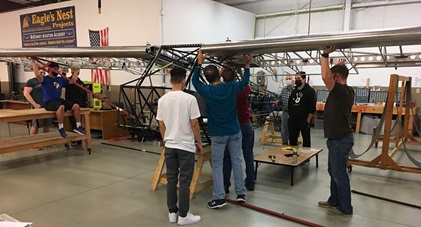STEM class building STOL Cub
Texas high school students constructing Legend Cub
A group of Dallas high school juniors and seniors is learning how to stitch fabric to tubes and wing ribs while constructing a short takeoff and landing (STOL) American Legend Aircraft Co. Legend Cub during a hands-on science, technology, engineering, and math (STEM) aviation build project.
“The students are psyched about the capabilities of this airplane,” said McKinney High School aviation and robotics teacher Keith Shelton. “Several students are really into aviation and they want to see what this airplane does when we put it together.”
“The STOL world is really hot, and several students are actively following the STOL Drag competitions,” said Shelton. Others are “ecstatic about the cloth covering. They’ve never seen Ceconite fabric work so it’s almost like you’re reviving a dead art.”
Shelton said the school was a natural for the tube-and-fabric project because “we’re almost right down the street from the Legend Cub factory,” which is located about 50 nautical miles due east at Sulphur Springs Municipal Airport.
This specific airplane the students are constructing will replace another Legend Cub currently owned by partners R.E. “Ernie” Butcher and Bruce Bohannon.
Butcher is president of Eagle’s Nest Projects, a national organization that provides STEM education experiences in aviation mostly through the construction process of two-seat Van’s Aircraft RV–12 light sport aircraft as a “hook” to pique students’ interest in science and aviation. He serves as the project’s lead mentor.
Bohannon is a name familiar to many aviators because he set numerous general aviation records in a Van’s Aircraft RV–4 and a Miller-Bohannon Formula One racer.
Teacher Shelton also brings real-world aviation experience to the program. He’s an instrument-rated private pilot with a multiengine rating, and an advanced ground instructor. He has been flying for about four years with plans to “hopefully add commercial and CFI” to his aviation credentials “by the end of school year.”

Most of the tubes have been pre-assembled but “there’s quite a bit of riveting, wing tip assembly, and final fitting” to be completed, said Shelton. So far, the students have covered most of the control surfaces and are waiting on a covering kit for the wings and fuselage. “The plumbing for the hydraulic brakes and the fuel system are mostly done, the rigging for the controls is mostly done, but nothing came wired” for the instruments. The class, which includes students from three schools—McKinney High School, McKinney North High School, and McKinney Boyd High School—hopes to install a Dynon Skyview panel, depending on resources.
“The students now have a good amount of experience with many of the systems but none of us have covered an entire wing before so it’s going to be an interesting project,” Shelton said. However, he added, “Our mentors have spent a good amount of time learning techniques from the specialists at Legend Cub because they’re so close by.”
McKinney High School is one of 450 AOPA High School Aviation STEM curriculum classrooms for ninth to twelfth graders. About 37 percent of the students participating in the curriculum are from minority backgrounds and more than 23 percent are female. McKinney students participated in the AOPA program’s testing phase before the curriculum was rolled out to other schools.
McKinney students previously built two Van’s Aircraft RV–12 airplanes, so construction supervisors have a proven track record of coaxing professional work ethics from the young people. Some of those former students are enrolled in aviation studies in college and have plans to become career pilots or mechanics.
Shelton said one of his current students has already decided to pursue an air traffic control career, and two others are exploring aerospace engineering. He said he talks with students about aviation opportunities every chance he can get. “This is the time to get into aviation,” he tells them. “It’s going to do nothing but blow up in the future. Even if the technology changes, you want to be in the middle of it.”
The You Can Fly program and the Air Safety Institute are funded by charitable donations to the AOPA Foundation, a 501(c)(3) organization. To be a part of the solution, visit www.aopafoundation.org/donate



